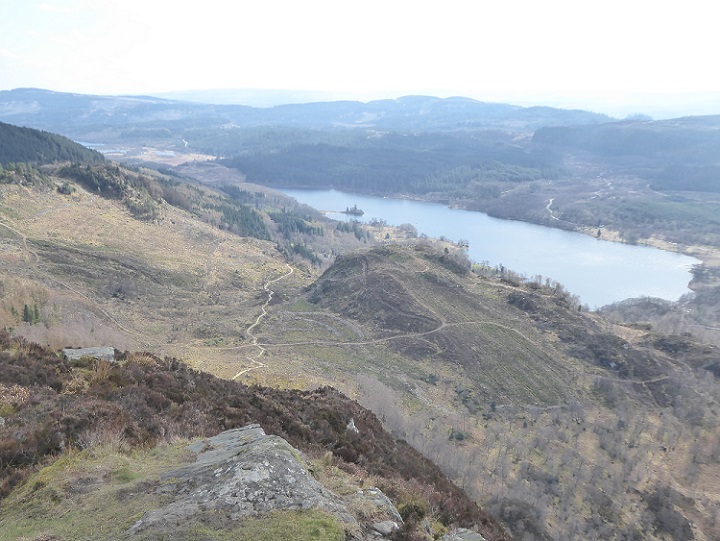
On Easter Saturday, I walked up the tourist path on Ben A’an, which was rebuilt in 2018 as part of the Mountains for People project and which I last wrote about two and a half years ago (see here). It was a nice day and, as I expected, very busy but that was one reason for my visit: I wanted to see what difference the expanded Forest and Land Scotland (FLS) car park, funded by the Rural Tourism Infrastructure Fund, had made.
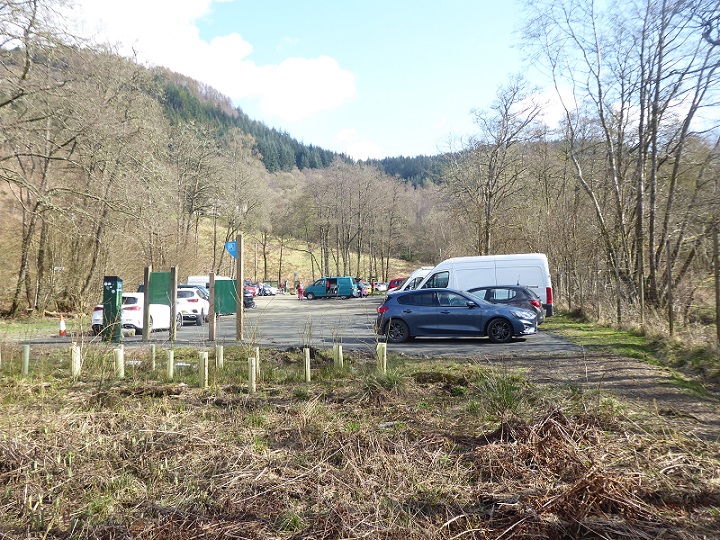
The car park was almost full when we arrived, an indication that in the absence of good public transport expanding its capacity to enable people to enjoy Ben A’An was quite justified. The Planning Report (see here) had noted that Forest and Land Scotland “have confirmed a commitment to provide a lay-by for a bus stop at a later date and this will be subject to a separate application”. Two years later there is still no sign of that.
Having required an assessment of the impacts that an expanded car park might have on the Special Area of Conservation (SAC) and concluded these could be mitigated (the car park has been expanded onto an area of rank vegetation – photo in my previous post), Loch Lomond and Trossachs National Park Authority (LLTNPA) planning staff allowed FLS to use polluting plastic plastic tree tubes right next to what is supposed to be a highly protected freshwater system. The photo above and the regenerating scrub on either side of the car park shows that was completely unnecessary.

Having secured central government funding (part of the £375k awarded for Visitor Management in the Trossachs) to expand the car park, FLS is now effectively charging £5 for people to use it and walk up Ben A’an as there are no options for walking along Loch Achray and no picnic facilities. £5 for a day might sound better than Argyll and Bute Council’s excorbitant charges at Arrochar (see here) but even very young children – and we saw a few – and those hillwalking for the first time are unlikely to take longer than 4 hours to walk up and down Ben A’an. The effective charge therefore is £5 for a half day or less. On a day like last Saturday the car park, which has around 90 places, is likely to have raised c£1k for FLS.
While extracting every penny it can from visitors, how much is FLS spending on visitor infrastructure in return?
The state of the tourist path up Ben A’An
The path, which is not yet five years old, has further eroded since my last post. Much of this is due to poor design and construction:
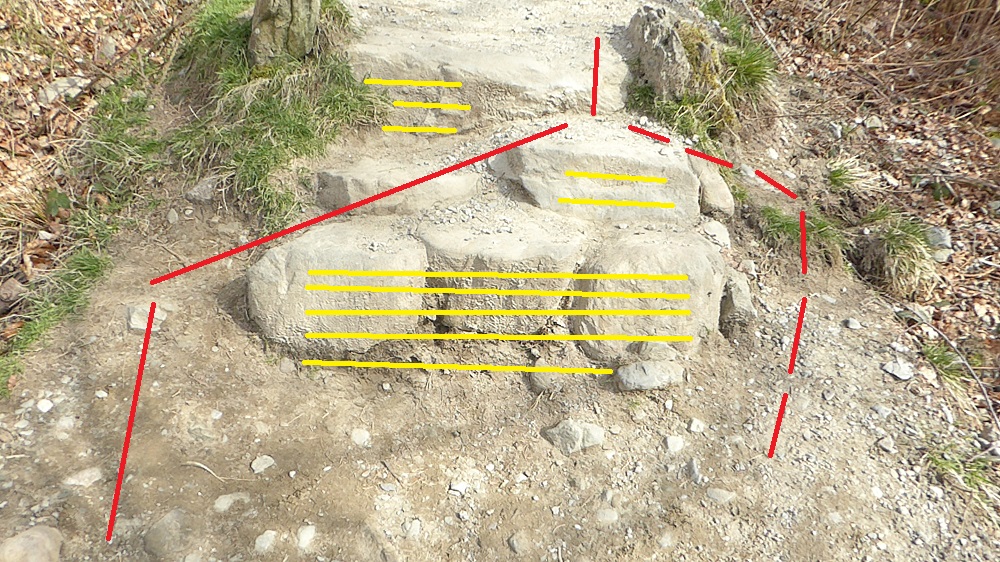
The main problems are the stepped sections, most of which were never fit for purpose, as illustrated by the photo above. Instead of making it easier for people to walk up the hill, the steps have served to form barriers, making it more difficult to use the path.
Most people avoid using steps over 20cms high both because of the effort this involves walking up and because they jar the knees going down. In this case, the height of the lowest step has increased since construction because the path surface below has been eroded away – more poor design! The consequence is that people try and walk round even where this is awkward. While the “Devil’s Ears” on either side of the top step have in this case been partially successful in keeping people to the top step, you can see how routes around them are gradually forming. When those routes become easier than taking the steps, most people will abandon the constructed path entirely.
This process is being repeated for almost all the stepped sections on the path:

In the example above, further design and construction flaws are apparent. The rounded nature of the large bottom step means that people have to stretch up even further to get a secure footing and in the wet few are likely to trust the smooth surface. If the rocks on either side, highlighted with a question mark, were intended to direct people to the step, they have failed completely: they are clearly worn by boots and some people are now walking over them in preference to taking the main step.
The damp earth below the boulder, marked by the yellow arrow, suggests it has only recently been exposed to the air by erosion of the ground below as it has not yet dried out. When it does, it is likely to crumble away gradually, a process which will in time leave the boulder unsupported. The red arrow shows where people have stepped on a clod of grass in preference to the step and how it too is gradually eroding away: once it does there will be nothing to stop the pebbles above from being washed over the step speeding up the erosion process further.
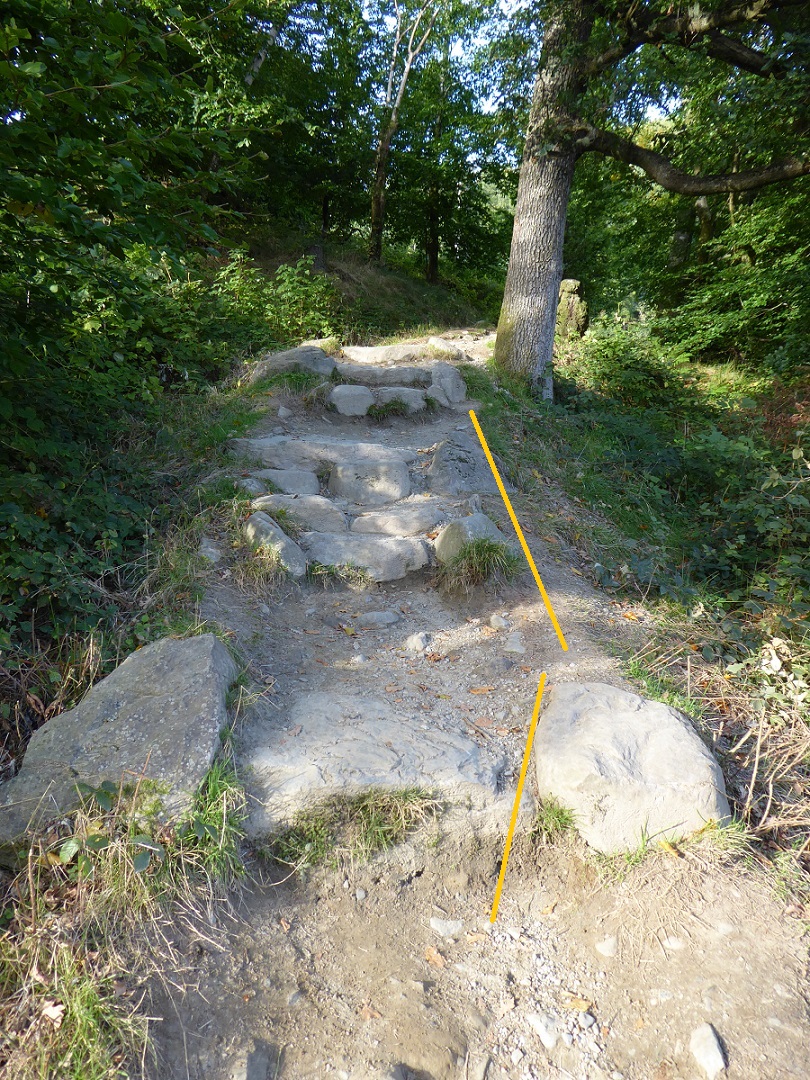
The speed with which the new path has failed to serve its intended purpose is illustrated by comparing the photo above with that below. Two and a half years ago some people were taking the rather awkward route marked by the yellow lines to avoid the step.
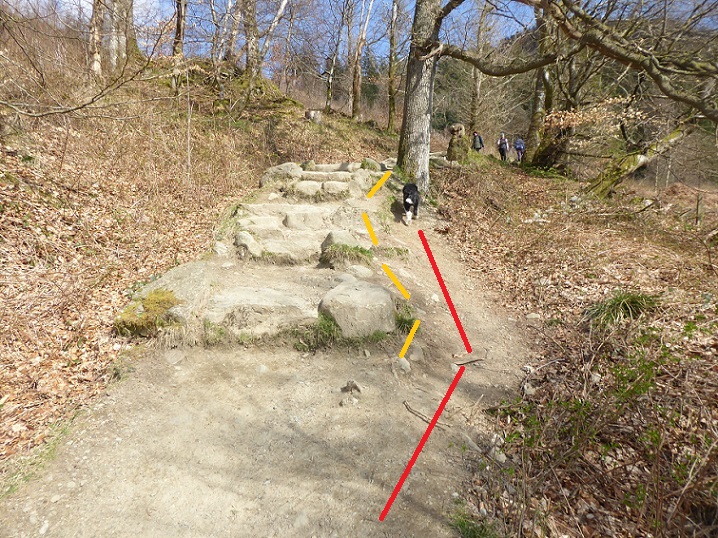
Since then that route, which I have marked with the dashed yellow line, has been been more or less abandoned and replaced by a new path below taken by the dog and marked by the red line. Humans are like animals and tend to take the easiest route! Looking at the first photo, this might have seemed an unlikely line but once people started trampling over vegetation to avoid the steps, the red line quickily developed into the preferred route.
How long now till the steps, commissioned by FLS, become completely redundant like those at Conic Hill (see here)? Perhaps the Heritage Lottery Fund , who funded the work, should ask FLS to investigate what has gone wrong or ask for their grant back.
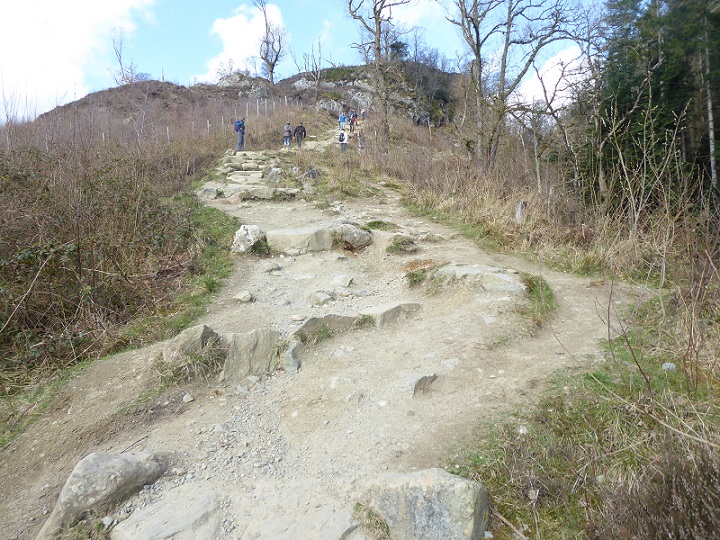
Higher up the hill, where the route is less constrained, people have been able to take longer diversions to avoid the steps spreading the erosion further.
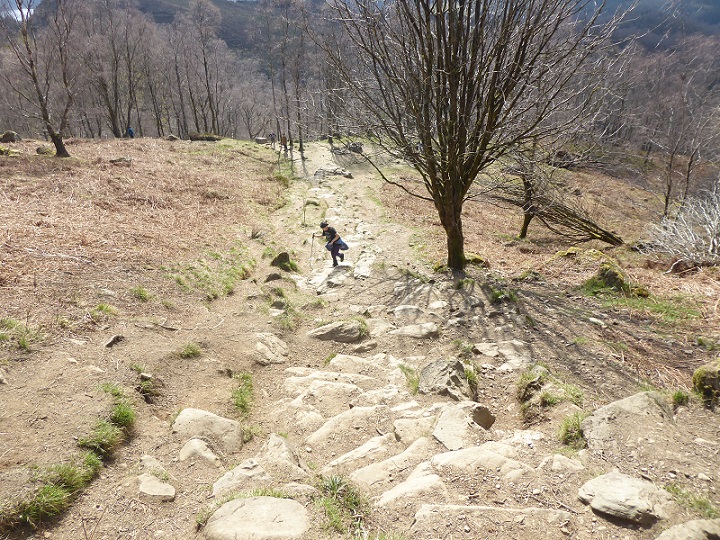 Even on the final third of the path, which ascends a fairly steep slope, people have been avoiding the steps where possible. This illustrates that designing and building a path that people will use on such ground is a skilled process. Unfortunately it appears that neither FLS nor the contractor had the skills necessary. A wasted opportunity and a wasted investment.
Even on the final third of the path, which ascends a fairly steep slope, people have been avoiding the steps where possible. This illustrates that designing and building a path that people will use on such ground is a skilled process. Unfortunately it appears that neither FLS nor the contractor had the skills necessary. A wasted opportunity and a wasted investment.
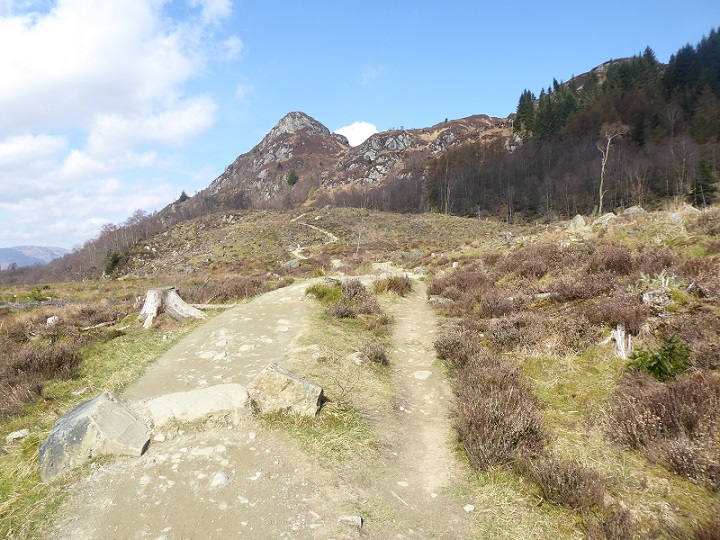
The problems are also apparent on the middle section of the path, which is gently rolling and has relatively few steps. Put them in the wrong place, however, leave a short cut and people will stop using what is otherwise a reasonably designed section of path.
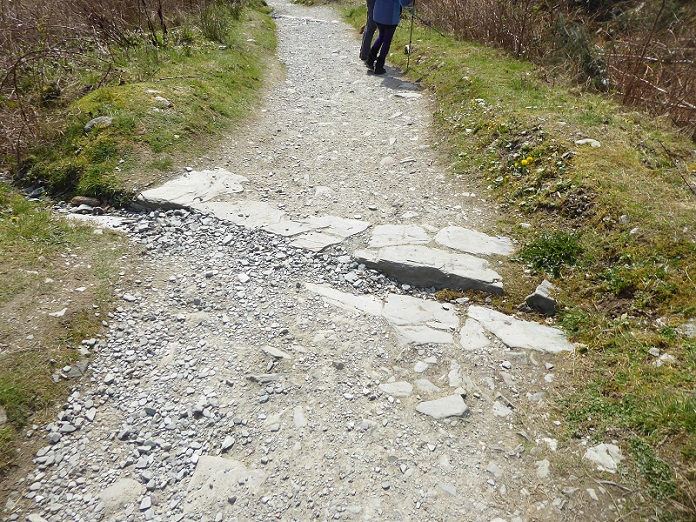
These design problems are being made worse as a result of a lack of maintenance by FLS. There is no point having drains across the path if water is able to flow over them. I could see no signs of maintenance, let alone of any remedial action to fix some of the design flaws. It would be easy enough, for example, to place a couple of felled tree trunks across the shortcut in the photo (two) above.
Instead, FLS appear to be leaving the problems to get worse, at which point they will no doubt go once again cap in hand to the lottery or the Scottish Government asking for funding for a new path, just as has happened at Conic Hill.
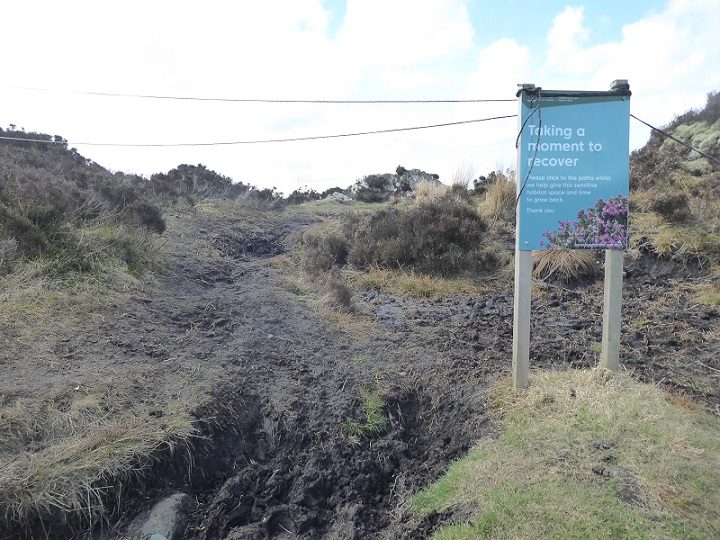
Near the summit of Ben A’An was this sign asking people to keep off what it described as “sensitive habitat”. One could question whether this heathery habitat is any more sensitive than that being eroded below, where there were no such signs. But the message wasn’t working and for good reason: 20m beyond the sign are fantastic views out across Loch Katrine and people want to enjoy these.
If FLS wanted to reduce the area of ground that is being eroded they could do so quite easily with a bit of judicious path work funded by some of the £1000s they are collecting from the Ben A’An car park. It is cheaper, however, to virtue signal with an occasional sign. That appears to be about as redundant as much of the path below.
Woodland regeneration at Ben A’an
Ben A’an is part of the Great Trossachs Forest, the largest woodland restoration project in the Loch Lomond and Trossachs National Park, which was declared a National Nature Reserve despite the shocking state of nature in the area (see here). Since then, however, FLS has gradually been restructuring its forests in the area, replacing conifer plantation with native woodland, and did so at Ben A’an around the time the path was constructed.
The landscape impact was brutal:

However, to give FLS credit, they chose to allow the native woodland to regenerate naturally and avoided planting trees, which would have further disturbed the soils and the fungal organisms on which native trees depend. That is quite a contrast to how they have managed their land elsewhere, including the Caledonian Forest in Glenmore (see here) and the car park below, with its plastic tree tubes.

Native trees are now regenerating in quantity all along the sides of path, a sign that FLS here has deer numbers under control whatever the purpose of the fence in the photo above (regeneration was taking place on both sides).

In the medium term the growth of trees may also serve to restrict the area around the path that is being eroded by feet.
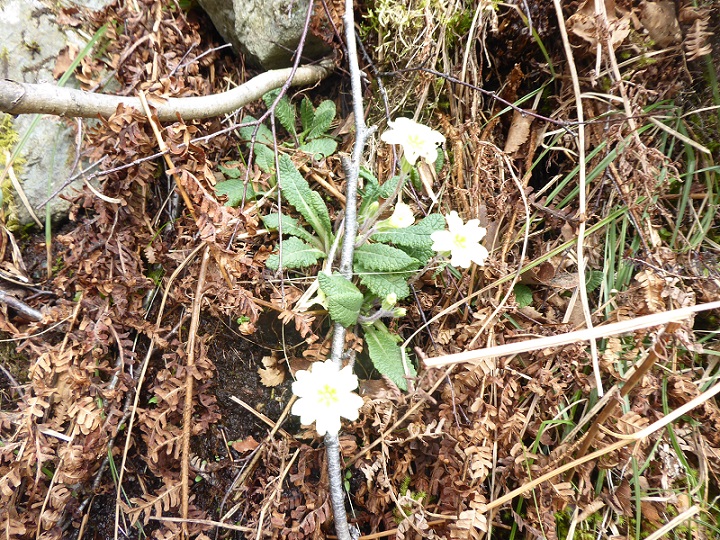
It was not only trees and shrubs (birch, holly, Scots Pine, willow, broom) that were regenerating, but also common flowers like primose, wood anemone and celandine. In a month’s time, when spring has fully sprung, I am sure there would be a lot more. That, however, was what I would have expected and was not what impressed me about how FLS’ land at Ben A’an, aside from the path, is being managed.

We know natural regeneration of woodland works and the reason why it is not far more widespread in Scotland is because of high deer and sheep numbers, muirburn and the vested forestry interests who would prefer to use public money to plant trees than let nature flourish. The real challenge with expanding native woodland, however, is not any of these factors which could be fixed for very little cost: it is how do we prevent naturally regenerating species of native plants becoming overrun with non-native species? The latter often seed more easily, grow quicker and are less palatable to herbivores making them less vulnerable to browsing.
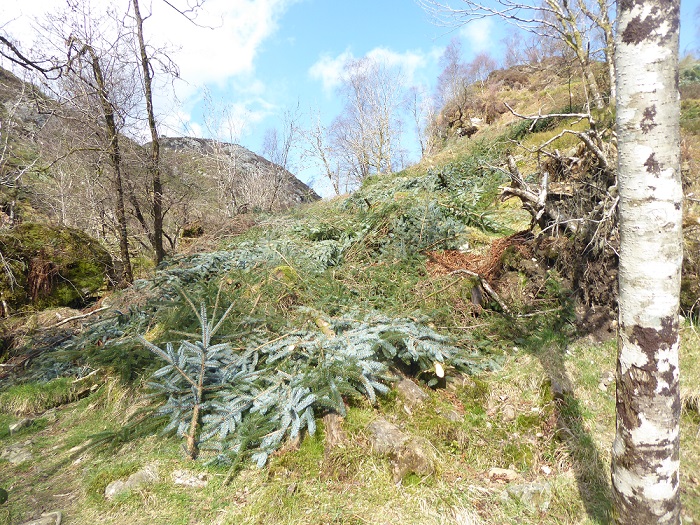
The answer is to fell/remove the non-native species before they become old enough to seed. That is exactly what has been happening at Ben A’an. If left in place after felling, as here, the earlier this happens, the smaller the area that will be shaded out, a way of helping the ground flora which depends on sunlight.

From what I saw FLS had been doing a very thorough job and I only saw a handful of non-native species along the corridor taken by the path.
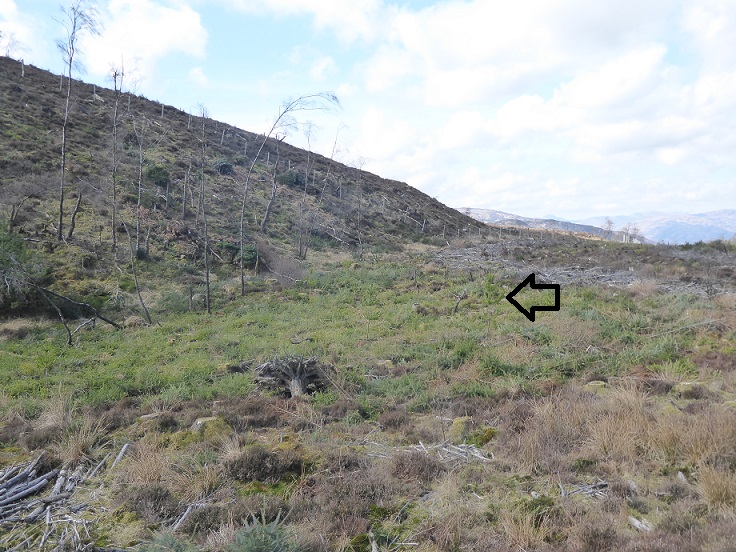
This commendable approach will require ongoing management, as non-native seed is likely to survive in the ground for some time. That could support local jobs, with locally based foresters weeding out non-native species and controlling deer numbers in the short-medium term and then in the longer-term harvesting some of the native trees for commercial use
Such management is alien to the current model of industrial forestry which FLS practices elsewhere, where trees are planted and then left and where there is no natural regeneration because deer fences are not maintained and deer numbers are too high.
Lesson from Ben A’an
What is happening at Ben A’An illustrates FLS both at its best, the approach to natural regeneration, and its worst, the way it has mismanaged the path and car park. Politicians from all Scotland’s political parties who have responsibility for or an interest in rural affairs, forestry or outdoor recreation could do far worse than take a short walk, see for themselves and then call for action.
The challenge which we need to tackle if we are to address the climate and nature emergencies is two fold. The first is to re-direct all the public funds that are currently used to plant trees behind ineffective deer fences to support long-term woodland management. This should primarily involve controlling deer numbers to enable natural regeneration but also weeding out non-native species in areas dedicated to native woodland. Such an approach should be applied across all land managed by FLS on behalf of the public.
The second is how the Scottish Government makes the payment of forestry subsidies dependant on landowners, whether public or private, actively supporting outdoor recreation. We need to enable more people to enjoy the countryside in Scotland rather than jetting off to other parts of the world with better tourist infrastructure. Insisting on transparency from FLS about how it is spending the money it collects from visitors at the Ben A’An and Ben Venue car parks and the creation of a new bus stop at the bottom of the Ben A’An path would be a small start!
A National Park that was fit for purpose should be driving these issues forward, pushing FLS to restructure far more woodland over its vast landholding in the Trossachs and to invest in outdoor recreation. Sadly, the LLTNPA has never shown any will to do this but has allowed FLS where to practice industrial forestry and where not and sat by while recreational investment has been cut. Having abandoned its outdoor recreation plan it has now given up the one means by which it could have influenced FLS to do more for people.
Perhaps we should employ Nepalis to build paths like they do in Norway. Even the long overdue new path up Conic hill, which is at least the third attempt, looks far from ideal.
Your analysis of the that path also applies to so many of our mountain paths it’s just not funny. Whenever I read of a stone pitched path in some walk’s instructions I groan because literally all the current methods of building them leave obstacles in the way of walkers. Drains across the whole width, with protruding rocks, which have no slope so can’t possibly with the best will in the world drain anything. Water bars with giant slabs on end across the path to stop gravel being washed into them, are just evil, and dangerous when tired. Steps which are tall so short people like me struggle both up and down, and down they are horribly damaging to knees. Let alone the many, many superfluous sets of steps. Stick a zigzag in like the old stalkers did. Many times I have given up with the path and walked by the side. I know I am therefore part of the problem, but what can you do when the path is simply not fit for purpose and causing pain. I’m sure the path builders blame us/me, but if their poorly designed and implemented path pushes us off it (for the sake of our knees and sanity) who then is really to blame!
Recently I did Beinn Eighe. The path to Spidean Coire nan Clach had helicopter bags of large rocks dumped on it. The local ranger explained they moved them to the side, and had nowhere else to dump them. Neither of which was true. Argh! what a mess. They’ve apparently started the rebuilding but I really fear what state they will leave it in. A superficiality pretty path which breaks basic engineering principles and the fundamental purpose that of building a path we will all want to keep to,